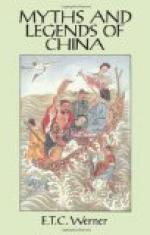Local Government
The central administration being a far-flung network of officialdom, there was hardly any room for local government apart from it. We find it only in the village elder and those associated with him, who took up what government was necessary where the jurisdiction of the unit of the central administration—the district magistracy—ceased, or at least did not concern itself in meddling much.
Military System
The peace-loving agricultural settlers in early China had at first no army. When occasion arose, all the farmers exchanged their ploughshares for swords and bows and arrows, and went forth to fight. In the intervals between the harvests, when the fields were clear, they held manoeuvres and practised the arts of warfare. The king, who had his Six Armies, under the Six High Nobles, forming the royal military force, led the troops in person, accompanied by the spirit-tablets of his ancestors and of the gods of the land and grain. Chariots, drawn by four horses and containing soldiers armed with spears and javelins and archers, were much in use. A thousand chariots was the regular force. Warriors wore buskins on their legs, and were sometimes gagged in order to prevent the alarm being given to the enemy. In action the chariots occupied the centre, the bowmen the left, the spearmen the right flank. Elephants were sometimes used in attack. Spy-kites, signal-flags, hook-ladders, horns, cymbals, drums, and beacon-fires were in use. The ears of the vanquished were taken to the king, quarter being rarely if ever given.
After the establishment of absolute monarchical government standing armies became the rule. Military science was taught, and soldiers sometimes trained for seven years. Chariots with upper storeys or spy-towers were used for fighting in narrow defiles, and hollow squares were formed of mixed chariots, infantry, and dragoons. The weakness of disunion of forces was well understood. In the sixth century A.D. the massed troops numbered about a million and a quarter. In A.D. 627 there was an efficient standing army of 900,000 men, the term of service being from the ages of twenty to sixty. During the Mongol dynasty (1280-1368) there was a navy of 5000 ships manned by 70,000 trained fighters. The Mongols completely revolutionized tactics and improved on all the military knowledge of the time. In 1614 the Manchu ‘Eight




